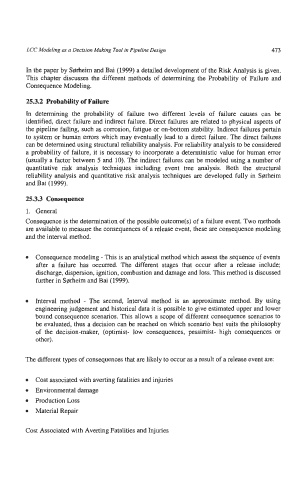Page 506 - Pipelines and Risers
P. 506
LCC Modeling as a Decision Making Tool in Pipeline Design 473
In the paper by S@rheim and Bai (1999) a detailed development of the Risk Analysis is given.
This chapter discusses the different methods of determining the Probability of Failure and
Consequence Modeling.
25.3.2 Probability of Failure
In determining the probability of failure two different levels of failure causes can be
identified, direct failure and indirect failure. Direct failures are related to physical aspects of
the pipeline failing, such as corrosion, fatigue or on-bottom stability. Indirect failures pertain
to system or human errors which may eventually lead to a direct failure. The direct failures
can be determined using structural reliability analysis. For reliability analysis to be considered
a probabiIity of failure, it is necessary to incorporate a deterministic value for human error
(usually a factor between 5 and lo). The indirect failures can be modeled using a number of
quantitative risk analysis techniques including event tree analysis. Both the structural
reliability analysis and quantitative risk analysis techniques are developed fully in SHheim
and Bai (1999).
25.3.3 Consequence
1. General
Consequence is the determination of the possible outcome(s) of a failure event. Two methods
are available to measure the consequences of a release event, these are consequence modeling
and the interval method.
Consequence modeling - This is an analytical method which assess the sequence of events
after a failure has occurred. The different stages that occur after a release include;
discharge, dispersion, ignition, combustion and damage and loss. This method is discussed
further in Sgjrheim and Bai (1999).
0 Interval method - The second, Interval method is an approximate method. By using
engineering judgement and historical data it is possible to give estimated upper and lower
bound consequence scenarios. This allows a scope of different consequence scenarios to
be evaluated, thus a decision can be reached on which scenario best suits the philosophy
of the decision-maker, (optimist- low consequences, pessimist- high consequences or
othcr).
The different types of consequences that are likely to occur as a result of a release event are:
0 Cost associated with averting fatalities and injuries
Environmental damage
0 Production Loss
Material Repair
Cost Associated with Averting Fatalities and Injuries

